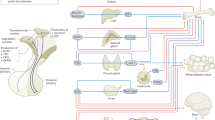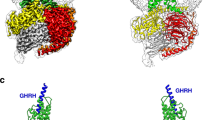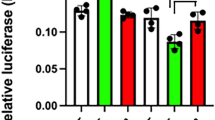Abstract
Hypothalamic peptide hormones regulate the secretion of most ofthe anterior pituitary hormones, that is, growth hormone, follicle-stimulating hormone, luteinizing hormone, thyroid-stimulating hormone and adrenocorticotropin1,2. These peptides do not regulate the secretion of prolactin1,2, at least in a specific manner, however. The peptides act through specific receptors, which are referred to as seven-transmembrane-domain receptors or G-protein-coupled receptors3,4,5,6,7. Although prolactin is important in pregnancy and lactation in mammals, and is involved in the development of the mammary glands and the promotion of milk synthesis8,9, a specific prolactin-releasing hormone has remained unknown. Here we identify a potent candidate for such a hormone. We first proposed that there may still be unknown peptide hormone factors that control pituitary function through seven-transmembrane-domain receptors. We isolated the complementary DNA encoding an ‘orphan’ receptor (that is, one for which the ligand is unknown). This receptor, hGR3, is specifically expressed in the human pituitary. We then searched for the hGR3 ligand in the hypothalamus and identified a new peptide, which shares no sequence similarity with known peptides and proteins, as an endogenous ligand. We show that this ligand is a potent prolactin-releasing factor for rat anterior pituitary cells; we have therefore named this peptide prolactin-releasing peptide.
This is a preview of subscription content, access via your institution
Access options
Subscribe to this journal
Receive 51 print issues and online access
$199.00 per year
only $3.90 per issue
Buy this article
- Purchase on Springer Link
- Instant access to full article PDF
Prices may be subject to local taxes which are calculated during checkout





Similar content being viewed by others
References
Reichlin, S. Neuroendocrinology of the pituitary gland. Toxicol. Pathol. 17, 250–255 (1989).
Koening, J. I. Pituitary gland: neurotransmitters and growth factors. Toxicol. Pathol. 17, 256–265 (1989).
Mayo, K. E., Miller, T. L., Dealmeida, V., Zheng, J. & Godfrey, P. A. The growth hormone-releasing hormone receptor: signal transduction, gene expression, and physiological function in growth regulation. Ann. NY Acad. Sci. 805, 184–203 (1996).
Kakar, S. S., Musgrove, L. C., Devor, D. C., Sellers, J. C. & Neill, J. D. Cloning, sequencing, and expression of human gonadotropin releasing hormone (GnRH) receptor. Biochem. Biophys. Res. Commun. 189, 289–295 (1992).
Hinuma, S. et al. Molecular cloning and functional expression of a human thyrotropin-releasing hormone (TRH) receptor gene. Biochim. Biophys. Acta 1219, 251–259 (1994).
Chalmers, D., Lovenberg, T. W., Grigoriadis, D. E., Behan, D. P. & De Souza, E. B. Corticotropin-releasing factor receptors: from molecular biology ot drug design. Trends Pharmacol. Sci. 17, 166–172 (1996).
Patel, Y. C. et al. The somatostatin receptor family. Life Sci. 57, 1249–1265 (1995).
Frantz, A. G. Prolactin. N. Engl. J. Med. 298, 201–207 (1978).
Lamberts, S. W. & Macleod, R. M. Regulation of prolactin secretion at the level of the lactotroph. Physiol. Rev. 70, 279–318 (1990).
Marchese, A. et al. Cloning and chromosomal maping of three novel genes, GPR9, GPR10, and GPR14, encoding receptors related to interleukin 8, neuropeptide Y, and somatostatin receptors. Genomics 29, 335–344 (1995).
Welch, S. K., O'Hara, B. F., Kilduff, T. S. & Heller, H. C. Sequence and tissue distribution of a candidate G-coupled receptor cloned from rat hypothalamus. Biochem. Biophys. Res. Commun. 209, 606–613 (1995).
Von Heijne, G. Anew method for predicting signal sequence cleavage site. Nucleic Acids Res. 14, 4683–4690 (1986).
Hurbain-Kosmath, I. et al. Gonadotropes in a novel rat pituitary tumor cell line, RC-4B/C. Establishment and partial characterization of the cell line. In Vitro Cell. Dev. Biol. 26, 431–440 (1990).
Samson, W. K., Said, S. I., Snyder, G. & McCann, S. M. In vitro stimulation of prolactin release by vasoactive intestinal peptide. Peptides 1, 325–332 (1980).
Samson, W. K., Lumpkin, M. D. & McCann, S. M. Evidence for a physiological role for oxytocin in the control of prolactin secretion. Endocrinology 119, 554–560 (1986).
Rivier, C., Brown, M. & Vale, W. Effect of neurotensin, substance P and morphine sulfate on the secretion of prolactin and growth hormone in the rat. Endocrinology 100, 751–754 (1977).
Erfurth, E. M., Hender, P., Lundin, S. & Ekman, R. Release of prolactin as well as adrenocorticotropin after administration of arginine-vasopression to healthy men. Horm. Metab. Res. 28, 599–602 (1996).
Hammond, P. J. et al. Signalling pathways mediating secretory and mitogenic responses to galanin and pituitary adenylate cyclase-activating polypeptide in the 235-1 clonal rat lactotroph cell line. J. Neuroendrocrinol. 8, 457–464 (1996).
Drouhault, R. et al. Prolactin and growth hormone release and calcium influx are stimulated by galanin within a ‘window range’ of concentrations in pituatary GH3 B6. Neuroendrocrinol. 60, 179–184 (1994).
Canonico, P. L., Schettini, G., Vandenegro, C. A. & MacLeod, R. M. Arachidonic acid metabolism and prolactin secretion in vitro: a possible role for the lipoxygenase products. Neuroendocrinol. 37, 212–217 (1983).
Reinscheid, R. K. et al. Orphanin FQ: a neuropeptide that activates an opioid-like G protein-coupled receptor. Science 270, 792–794 (1995).
Meunier, J. C. et al. Isolation and structure of the endogenous agonist of opioid receptor-like ORL1receptor. Nature 377, 532–535 (1995).
Cox, K. J. A. et al. Cloning, characterization, and expression of a G-protein-coupled receptor from Lymnaea stagnails and identification of a leucokninin-like peptide, PSFHSWSamide, as its endogenous ligand. J. Neurosci. 17, 1197–1205 (1997).
Sakurai, T. et al. Orexins and orexin receptors: a family of hypothalamic neuropeptides and G protein-coupled receptors that regulate feeding behavior. Cell 92, 575–585 (1998).
Koyama, N., Kuriyama, M., Amano, N. & Nishimura, O. Anovel procedure for the preparation of biologically active recombinant peptides using a cyanylation reaction. J. Biotechnol. 32, 273–281 (1994).
Nakagawa, S. et al. Chemical cleavage of recombinant fusion protein to yield peptide amides. J. Am. Chem. Soc. 116, 5513–5514 (1994).
Miyamoto, Y. et al. Cloning and expression of a complementary DNA encoding the bovine receptor for pituitary adenylate cyclase-activating polypeptide (PACAP). Biochim. Biophys. Acta 1218, 297–307 (1994).
Shiota, K. et al. In vitro thyrotroin release with thyrotropin-releasing hormone and an analogue, DN-1417. Acta Endocrinol. 106, 71–78 (1984).
Hyde, J. F., Murai, I. & Ben-Jonathan, N. The rat posterior pituitary contains a potent prolactin-releasing factor: studies with perfused anterior pitutitary cells. Endocrinology 121, 1531–1539 (1987).
Acknowledgements
We thank H. Okazaki and K. Tsukamoto for discussions throughout this study, and Y. Ishibashi, J. Noguchi, Y. Matsumoto, T. Moriya and M. Suenaga for collaboration.
Author information
Authors and Affiliations
Corresponding author
Rights and permissions
About this article
Cite this article
Hinuma, S., Habata, Y., Fujii, R. et al. A prolactin-releasing peptide in the brain. Nature 393, 272–276 (1998). https://doi.org/10.1038/30515
Received:
Accepted:
Issue Date:
DOI: https://doi.org/10.1038/30515
This article is cited by
-
A rare human variant that disrupts GPR10 signalling causes weight gain in mice
Nature Communications (2023)
-
An analogue of the Prolactin Releasing Peptide reduces obesity and promotes adult neurogenesis
EMBO Reports (2023)
-
Lipidated PrRP31 metabolites are long acting dual GPR10 and NPFF2 receptor agonists with potent body weight lowering effect
Scientific Reports (2022)
-
Central regulation of feeding behavior through neuropeptides and amino acids in neonatal chicks
Amino Acids (2019)
-
The hindbrain is a site of energy balance action for prolactin-releasing peptide: feeding and thermic effects from GPR10 stimulation of the nucleus tractus solitarius/area postrema
Psychopharmacology (2018)
Comments
By submitting a comment you agree to abide by our Terms and Community Guidelines. If you find something abusive or that does not comply with our terms or guidelines please flag it as inappropriate.



